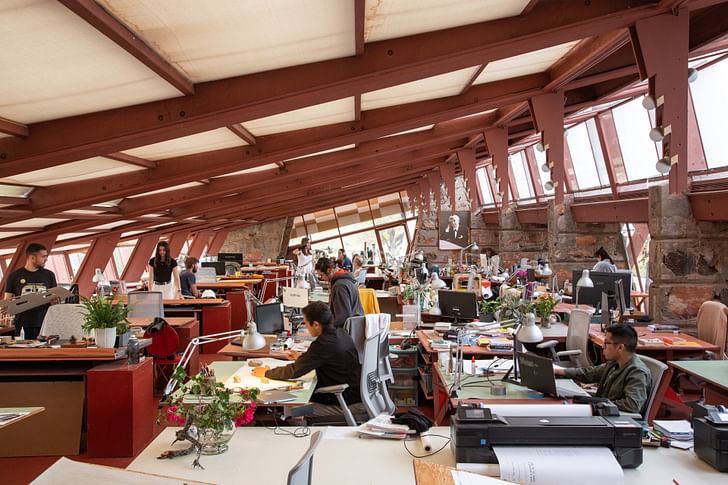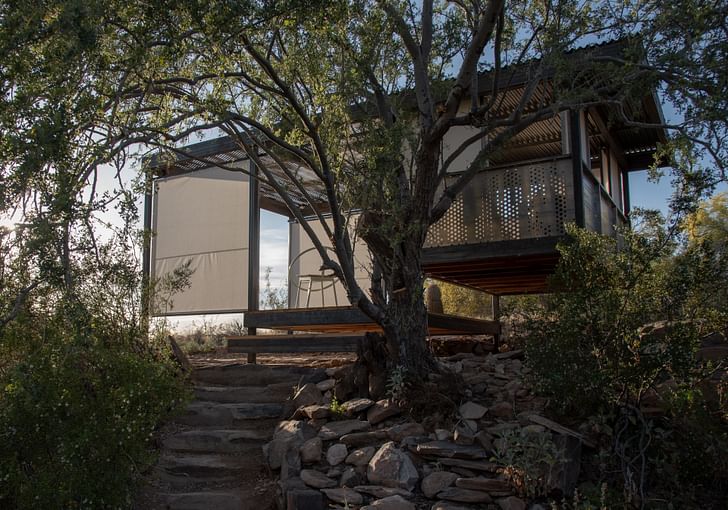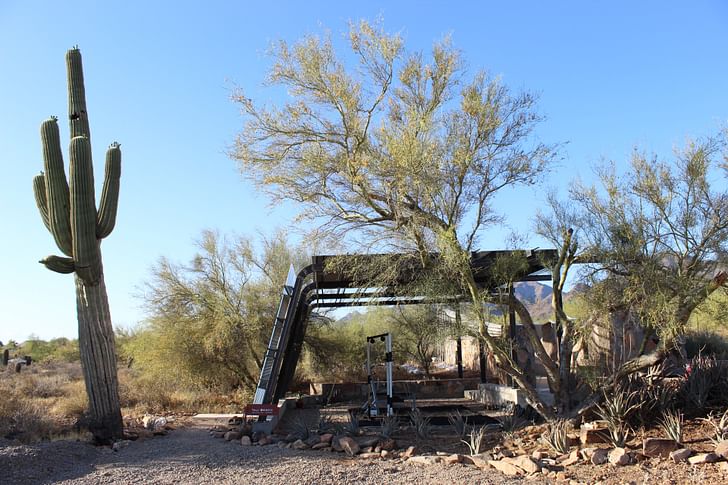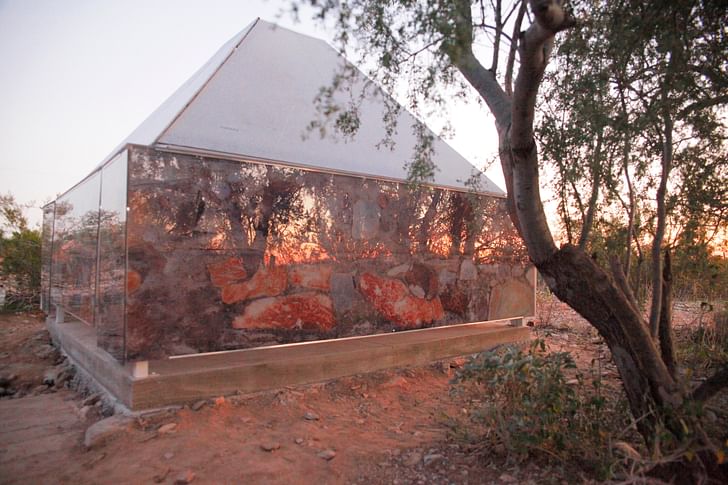

Archinect has collected responses from several School of Architecture at Taliesin (SoAT) students in light of recent events at the schools. The responses highlight the self-built pavilions SoAT students are expected to complete as part of their final thesis project.
Last week, the Board of Directors of the School of Architecture at Taliesin announced it would be walking back their decision to close SoAT due to student and public outcry and as additional funding has become available. This sounds like great news; however, there’s no saying whether or not this decision will stay. As has been reported previously, the School is a tenant of the Foundation and still relies on the Foundation’s good wishes to provide access to the very campuses (two UNESCO World Heritage sites) they use for classes, studios, lectures, pinups, and installation projects.
SoAT also obtained formal independence in 2017 from the Frank Lloyd Wright Foundation in order to comply with updated NAAB accreditation requirements. This autonomy, combined with new faculty and the leadership of SoAT President Aaron Betsky and SoAT Dean Chris Lasch, means that the school is primed to engage with contemporary architecture as it exists beyond Taliesin. Since then, the school has been able to act with a zoomed-out, historically-sensitive perspective that has maintained and even expanded its relevance within architectural discourse.
For decades prior to its NAAB accreditation in 1997, SoAT was a legacy institution whose relevance went only as far as Wright’s ideas could be replicated or improved upon. Gaining its formal (though not complete) independence from the Foundation meant the school could finally embrace its role as a comprehensive contemporary school of architecture that attracts speakers, critics, and discourse no other school of its size could. Things were looking incredibly bright.
As architecture schools increasingly adopt the same buzzword ethos of “learning while doing,” the SoAT makes it work.
It’s hard to communicate how rare this place is unless you visit. For one, the students live in pavilions built by other students and then build shelters to be inhabited by future students, all while taking courses on contemporary theory, running an amazing publication, and cooking dinner for each other. No other school could ever get away with that. As architecture schools increasingly adopt the same buzzword ethos of “learning while doing,” the SoAT actually makes it work.
Despite all this, the school’s nascent trajectory is currently under threat by the Foundation.
Three recent graduates reached out to Archinect to reflect on their time at SoAT and what the threat of closure means to them. Our hope is that their words continue to put enough pressure on the Foundation to stay true to their agreement with SoAT and to also grant the school a protected autonomy against future moves to disregard Wright’s legacy.

Having graduated from the M.Arch program at SoAT in May 2019, the news that SoAT would be closing at the end of the Spring 2020 semester came as a shock to me; a hugely disappointing one at that. In the weeks since, while attempting to uncover details about the situation to understand how we got here, the uniqueness of the Taliesin experience has come into increasingly sharper focus.
I chose to pursue my architectural training at Taliesin for a number of reasons, but none more integral than for the opportunity to design and build a shelter in the Sonoran Desert. This has been a trademark of a long-running program that in many ways has come to define the unconventional school and community at Taliesin West. The construction and inhabitation of simple desert dwellings is the embodiment of Frank Lloyd Wright’s definitive attitude about mastering the craft: We learn best by doing.
I chose to pursue my architectural training at Taliesin for a number of reasons, but none more integral than for the opportunity to design and build a shelter in the Sonoran Desert.
The shelter process ensures an experience of contemplating nature and facing the challenging realities of making buildings. Weather and climate are engaged directly. Budget restraints weigh heavily, materials are sourced, labor is scheduled, and building techniques are learned. In a matter of months, I dug and poured footings, learned to weld, and was soon sleeping in my handmade dwelling in the desert. Where else could this dream come true?
At SoAT – in unparalleled uniqueness – students make buildings before becoming architects. In an era where staring endlessly into computer screens has become the professional norm and with academia increasingly content to produce paper architecture, the value of this building experience cannot be overstated.
To think that this small-but-mighty institution of hands-on education – this mecca of organic architecture where students still get their hands dirty – will close its doors to future generations of aspiring architects is devastating to those of us who have benefitted so much from the education we received there. It is a loss for the global architecture community. SoAT, as an accredited master’s degree program, seemed to have solidly positioned itself as not only the intended continuation of Frank Lloyd Wright’s legacy, but as a one-of-a-kind school offering a contemporary, practice-based education to deeply committed students.
At SoAT – in unparalleled uniqueness – students make buildings before becoming architects.
As we wade through justifications for the school’s unfortunate closing, it feels as though there is a critical failure to see the forest for the trees. Taliesin is a place where architecture lives and breathes and has done so for nearly a century. Its students provide the soul and lifeblood that has infused the place with a vibrant and evolving pulse over its 88-year history. To lose them would forever diminish the significance of Taliesin, and would directly contradict the intentions of Frank Lloyd Wright. I can only hope the powers that be reconsider their decision.

As a recent former student, I can attest that the School of Architecture of Taliesin influenced my cohorts’ training more than I could have ever imagined. As someone who received their undergraduate education at a larger institution, University of Nevada Las Vegas, SoAT gave us the highly personalized accredited graduate education we all dreamed of. Our courses – covering legal contracts, specifications and building construction, computational design, integrated building systems – were taught by professors who are deeply ingrained and respected in their professional specializations (As a side note, I must thank them for their help in passing 3 of 6 architectural exams within the first year of graduating). This robust education informed our studio work not only in terms of practical issues, but it also enriched a theoretical background that Betsky and Lasch brought forward with discussions in our studio courses. Our portfolios and our learned work ethic gave us the opportunity to intern/volunteer for world-acclaimed and contemporary firms.
As students, we learned in-depth about Frank Lloyd Wright’s legacy by reading and discussing Wright's work and how his values transferred to affect society and the built environment.
Organic Architecture isn’t about the commodification and parodying of Wright’s work into trinkets, postcards, and chess sets. It isn’t about reducing Wright’s life into a tour guide’s poorly told and over-sensationalized stories to turn a couple of dollars (well, a lot of dollars, what do I know…). While these tours occurred in Wright’s time, they were primarily used to fuel Wright’s and the Fellowship’s relentless experimentation on the grounds of the two campuses: Taliesin and Taliesin West. The point of these tours are not just to give an intimate account of where the drawings were produced for the Guggenheim Museum, Fallingwater, and the Hollyhock House. Instead, these tours are to demonstrate the spirit of experimentation and dedication to Organic Architecture behind Wright’s body of work, which owes a lot of its proliferation to the efforts of the Fellows and students. As students, we learned in-depth about Frank Lloyd Wright’s legacy by reading and discussing Wright's work and how his values transferred to affect society and the built environment.
Just like the Fellows, we learned how to embody Wright’s tenacity by constructing our thesis projects to not only provide shelter but also to question the society that has been built around them. If I learned one thing at Taliesin, it was how the profession of architecture can become a lifestyle full of meaningful work. In finding meaning and value in our lives, we inject even more care into the work we produce for our communities, environment, and society. In other words, we do not treat our work at the Taliesin community as an 8-5 job of soulless obligation. Instead, we learned to give architecture the proper respect it demands. Instead, we learned to become community leaders who embody the needs of our constituents, in large part, because we knew that one day we would shape the built environment directly as licensed architects.
we do not treat our work at the Taliesin community as an 8-5 job of soulless obligation. Instead, we learned to give architecture the proper respect it demands. Instead, we learned to become community leaders who embody the needs of our constituents, in large part, because we knew that one day we would shape the built environment directly as licensed architects.

As we move toward the creation of a potential replacement for the SoAT with the new FLWF-led K-12 programs, in keeping with the educational component needed to allow the FLWF to continue to operate under Mr. Wright’s Will, we see forgotten lessons from the previous decades coming to light. The essence of the Taliesin community is not something that can be taught in seminars, study abroad trips, or other for-profit, short term endeavors. Both Taliesin and Taliesin West possess an initially overwhelming kinesthetic experience that begins to subside after the first year or two. Careful analysis of all the past students’ construction projects and their architectural details can only occur by living on the campuses full-time. Only with time and immersion will a layered understanding of Wright’s Organic Architecture principles become apparent. We students realized all the efforts and dedication it took in the Taliesin community to not only learn how to design but also how to build in a radical manner. We have learned not to pursue a style, starchitect status, or to rely only on branding. We learned that everyone before us dedicated a part of their lives and souls in order to allow us to experience Taliesin as students. We learned that Taliesin is the home of Organic Architecture. Ultimately, through washing dishes, cooking, and being there for each other, we learned that we produce stronger and more meaningful work by listening to our community’s needs, setting aside our differences, and giving a part of our lives to each other. This is something that cannot be taught. It can only be experienced through being a real dedicated community member at Taliesin.

The story of my final year at The School of Architecture at Taliesin begins in China’s Pearl River Delta. It was the summer before my last semester and I was fulfilling my internship requirement. I spent my time working and thinking about my thesis, eating bananas and pineapples, and drinking milk tea. This was paradise for any architecture student about to embark on their thesis project. I felt ready to return to school and begin.
Three weeks before classes started my father was diagnosed with advanced stage cancer. I didn’t know it yet but this news would define my thesis and what Taliesin would come to mean for me. On August 15th, I was in Spring Green, Wisconsin for the first day of school at the Taliesin campus. There were a lot of storms that fall, full of rain and lightning.
The dean and our thesis advisors were always there. Even the president of the school was always there. We prepared food together, ate together, and then did all the dishes together. Some of us even pulled the food we ate out of the ground together.
There were six of us in thesis semester. We would often be in the studio all night working. The dean and our thesis advisors were always there. Even the president of the school was always there. We prepared food together, ate together, and then did all the dishes together. Some of us even pulled the food we ate out of the ground together. We all shared the subconscious knowledge that our time together was coming to an end.

October 17th is when migration began that year, when the school collectively packed all our belongings into a truck and set off for Scottsdale, Arizona to start the next half of the year at Taliesin West. I drove the truck across the country, taking turns with another student in order to stay awake. As we put miles behind us, the landscape changed from meadows, to mountains, to desert. Arizona welcomed us with sun, warmth, and a collection of dwellings scattered in the desert: the thesis projects of past students. This legacy had intimidated me in my first year; but now I was eager to join it. This was my last Taliesin migration. The distance between my father and I had more than tripled.
I had half a semester left to build my thesis project if I wanted to graduate on time. I asked my fellow students for help and they did. Some had building experience, others had fundraising experience, but all of them helped me carry sixty-five 80-pound bags of concrete through the desert to my site. A professor rented a pickup truck for us. A former employee helped me construct my project in his shop. I had daily meetings with the president of the school to track my progress. 88 years of Taliesin momentum was behind me.
I graduated December 18th and as I looked around the room that night, I thought to myself: “I will miss these people and this place. Taliesin gave my life meaning, it gave me people I can rely on, and it trained me to survive and to prevail.”
November 13th the distance between my father and I had increased to infinity. Construction was underway, fundraising was almost done. Materials had been ordered and I had learned to weld. At 2AM, I arrived with the prefabricated portions of my thesis on a flatbed truck. To my surprise, the entire school – all 15 students – were there waiting to help me offload it. With their help my thesis, was completed on a December afternoon.
Site: 168 was a campsite my father used to take me to when I was a kid. It is a place made mystical because of the lessons and experiences it fostered. My thesis bears the same name because Taliesin – like the original Site: 168 – served as the medium for lessons and experiences of equal richness. Taliesin gave me wisdom I will spend years cultivating.
I graduated December 18th and as I looked around the room that night, I thought to myself: “I will miss these people and this place. Taliesin gave my life meaning, it gave me people I can rely on, and it trained me to survive and to prevail.”
3 Comments
The School of Architecture at Taliesin's design-build Shelter Thesis is an exceptional, one-of-a-kind maturation process for young architects that profoundly informs their architectural aesthetic in an organic, regeneratively-oriented environment. This process of nurturing young architects' talents begun 88 years ago by Frank Lloyd Wright in the Sonoran desert at Taliesin West is something the architectural community as a whole should actively seek to foster. The current students at SOAT have started a petition at Change.org asking for support of their initiative to continue this Master's Program that is at risk of ending. You can sign their petition at:
https://www.change.org/p/frank...
or post comments to this article letting the students know you support this Program continuing.
Thank you,
Kimberly Hurtado, J.D., CM-BIM, LEED Associate
Adjunct Professor, SOAT
Knowing the authors personally, each of their experiences articulated above is pure poetry. I am in awe of their capture of the program, a school scaled so small it can't help but be one of the most profound, intimate times of one's life. They capture how interwoven the school is with the landscape, with Wright's walls, with the living community that thrives there still -- that can't be transplanted: it's a part of the Genius Loci.
Having graduated from this most American, most unique accredited program myself, they show that nothing compares to the traditions and living education that is growing in number and fame.
The Foundation's plans will be enhanced by the historic, consistent school, and the school literally built the buildings it dwells in and interacts with those raised on the site. I encourage readers to insist: the Foundation's paramount care is of the LIVING part of Taliesin, not just the walls.
Christopher Lock
M.Arch 2018
To the school, supporters and most of all all the students past and present Illegitimi non carborundum!!!
Block this user
Are you sure you want to block this user and hide all related comments throughout the site?
Archinect
This is your first comment on Archinect. Your comment will be visible once approved.